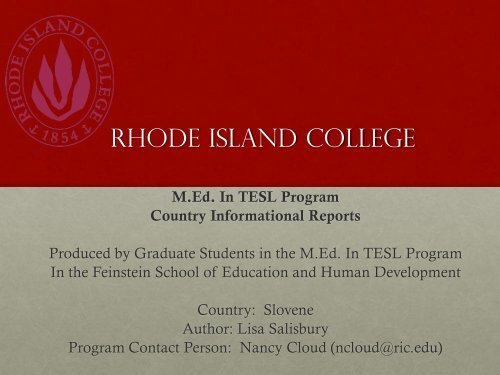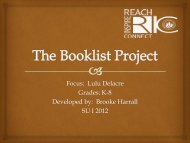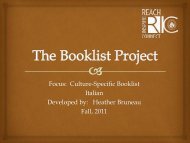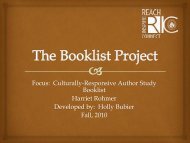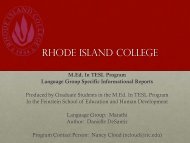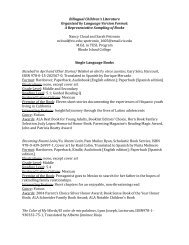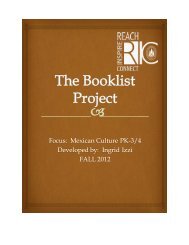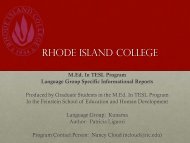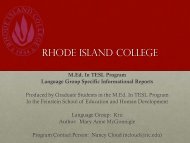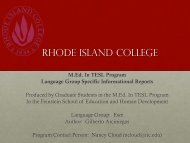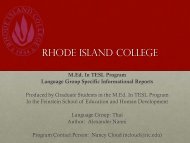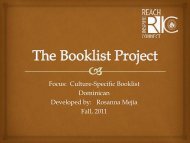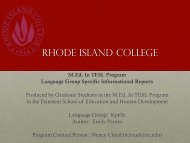Slovene: Official Language of Slovenia - RITELL
Slovene: Official Language of Slovenia - RITELL
Slovene: Official Language of Slovenia - RITELL
Create successful ePaper yourself
Turn your PDF publications into a flip-book with our unique Google optimized e-Paper software.
Rhode Island College<br />
M.Ed. In TESL Program<br />
Country Informational Reports<br />
Produced by Graduate Students in the M.Ed. In TESL Program<br />
In the Feinstein School <strong>of</strong> Education and Human Development<br />
Country: <strong>Slovene</strong><br />
Author: Lisa Salisbury<br />
Program Contact Person: Nancy Cloud (ncloud@ric.edu)
+<br />
<strong>Slovene</strong><br />
Popa, 2011<br />
Popa, 2011<br />
<strong>Official</strong> <strong>Language</strong><br />
<strong>of</strong> <strong>Slovenia</strong><br />
By Lisa Salisbury<br />
February 2012
+ <strong>Slovenia</strong><br />
A country in Central Europe touching the Alps and<br />
bordering the Mediterranean, Italy, Croatia, Hungary,<br />
Austria, and the Adriatic Sea.<br />
<strong>Slovene</strong> <strong>Language</strong><br />
Native language <strong>of</strong> about<br />
88% <strong>of</strong> <strong>Slovenia</strong>’s<br />
population<br />
5 dialect bases<br />
incorporating 50 varying<br />
dialects<br />
Also spoken in parts <strong>of</strong><br />
Italy, Austria, Hungary, and<br />
Croatia<br />
Wikipedia, 2012<br />
Ager, 2012
+<br />
Dialects<br />
<strong>Slovene</strong> is an Indo-European<br />
language from South Slavic branch <strong>of</strong><br />
the Slavic languages, like Serbian<br />
and Croatian.<br />
The spoken and written language is<br />
uniform and standardized.<br />
Dialects’ differ considerably in<br />
phonology, vocabulary and grammar<br />
46 clearly defined dialects, divided<br />
into six regional groups: Carinthian,<br />
Upper Carniolan, Lower Carniolan,<br />
Littoral, Rovte, Styrian and Pannonian<br />
Dialect Regions in <strong>Slovenia</strong><br />
Dnik, 2009<br />
Ager, 2012; Dular, 2001
+<br />
Characteristics <strong>of</strong> <strong>Slovene</strong><br />
Dual grammatical number<br />
2 accentual norms: Pitch accent, Abundant inflection<br />
Tense-Verb distinction<br />
Flexible word order-adjusted for emphasis/stylistic reasons<br />
Stress can fall on any syllable <strong>of</strong> a word<br />
Pronounce every letter in words<br />
Second-person plural forms used for individuals as sign <strong>of</strong> respect<br />
Word endings express number, gender, and relationship between<br />
different words in sentence<br />
Wikipedia, 2012; Komar, 2006
+ Written Alphabet & Pronunciation<br />
Letter Name IPA Letter Name IPA<br />
A, a a /a/ M, m em /m/<br />
B, b be /b/ N, n en /n/<br />
C, c ce /ts/ O, o o /ɔ/, /o/<br />
Č, č če /tʃ/ P, p pe /p/<br />
D, d de /d/ R, r er /r/<br />
E, e e /ɛ/, /e/, /ə/ S, s es /s/<br />
F, f ef /f/ Š, š eš /ʃ/<br />
G, g ge /g/ T, t te /t/<br />
H, h ha /x/ U, u u /u/<br />
I, i i /i/ V, v ve /v/, /w/<br />
J, j je /j/ Z, z ze /z/<br />
K, k ka /k/ Ž, ž že /ʒ/<br />
L, l el /l/, /w/<br />
Ager, 2012
+<br />
Phonology<br />
h pronounced /x/ save before voiceless consonants and after i when /h/<br />
lj pronounced /lj/ save before consonants, i and at the end <strong>of</strong> a word when /λ/<br />
l is pronounced as /u/ in past participles and sometimes in other words<br />
m is pronounced /ɱ/ before f and v<br />
n is pronounced /ŋ/ before g and k<br />
nj are pronounced /nj/ save before consonants, i and at the end <strong>of</strong> a word when<br />
/ɲ/<br />
<strong>Slovenia</strong>n r is always rolled like in Spanish or Italian<br />
g and k are aspirated in short imperatives and interrogatives<br />
/w/ is pronounced before vowels as well as j, l and r, while /ʍ/ before<br />
consonants<br />
/ə/ is always pronounced before syllabic l, m, n, and r<br />
/ː/ denotes long vowel<br />
Ager, 2012
+ Difficulties with English<br />
Mispronunciations <strong>of</strong> English words due to:<br />
Distinction between /I/ ad /i:/ is neutralized and instead <strong>of</strong> two<br />
individual sounds, a variant <strong>of</strong> the <strong>Slovene</strong> /i/ is pronounced,<br />
similar to schwa.<br />
When /i:/ is followed by a voiceless consonant, vowel is reduced<br />
in length: to <br />
Difference between the two vowels /æ/ and /e/ is neutralized<br />
and both end up sounding like the <strong>Slovene</strong> /ɛ/: to <br />
and to <br />
/a:/, /ʌ/ tend to be neutralized to one sound, the <strong>Slovene</strong> /a/<br />
No Standard <strong>Slovene</strong> counterpart for English /ʊ/, pronounced as<br />
/u:/<br />
Komar, 2006
+ Difficulties with English<br />
<strong>Slovene</strong> does not have the allophones [tr] or [ts]: ,<br />
; thus producing these sounds in English might be<br />
difficult.<br />
When 3 consonants occur in a sequence and central one is<br />
/t/ or /d/, latter is likely to disappear: to /lef<br />
‘wɪŋ/<br />
/h/ disappears in the normal forms <strong>of</strong> pronouns and in the<br />
auxilliary verb have: to /ɪm/<br />
/v/ disappears in normal form <strong>of</strong> the word “<strong>of</strong>” before / /:<br />
to /’lɒts ə ðəm/<br />
English sounds difficult to make due to tongue position:<br />
/æ/, /ŋ/, /h/, /ø/, /ð/<br />
Sustarsic (n.d.), Komar, 2006
+ <strong>Slovene</strong> vs. English<br />
<strong>Slovene</strong><br />
<strong>Language</strong> uses inflections to mark<br />
cases, therefore word order is<br />
liable to change<br />
Nucleus need not fall on a lexical<br />
item, may also fall on a function<br />
word<br />
3 basic tone groups: fall, rise,<br />
level tone<br />
English<br />
Word order is predominantly<br />
fixed (S-P-O)<br />
Nucleus falls on last lexical item<br />
in word group<br />
5 basic tone groups: fall, fall-rise,<br />
rise, rise-fall, level tone<br />
Sustarsic (n.d.), Komar, 2006
+<br />
Culture Notes<br />
It is important to ask how a person is doing and really<br />
listen to their answer before moving on to the purpose<br />
<strong>of</strong> the conversation, if there is one.<br />
<strong>Slovene</strong>s are neither overly direct nor indirect in their<br />
communication style. The norm is somewhere in between.<br />
An arm’s length <strong>of</strong> personal space during conversation is<br />
usually the norm.<br />
To stay on the safe side, it’s best not to touch too much until<br />
you have established a good relationship.<br />
Landers & Grossman, (n.d.)
+<br />
Culture Notes cont’d<br />
Normally it’s appropriate and expected to have some<br />
eye contact with the person you’re talking to in order to<br />
show that you’re listening to her/him. However,<br />
constantly staring at someone’s eyes could be <strong>of</strong>fensive.<br />
When interacting with good friends and family a<br />
normal amount <strong>of</strong> touching is usually acceptable,<br />
regardless <strong>of</strong> sex.<br />
Punctuality is in most cases valued and people<br />
normally do covet their time.<br />
Landers & Grossman, (n.d.)
+<br />
Resources<br />
Ager, S. (2012). <strong>Slovenia</strong>n. Omniglot: Writing systems and languages <strong>of</strong> the world.<br />
Retrieved February 2, 2012, from: http://www.omniglot.com/writing/slovene.htm<br />
Ceferin, A. (2007). Introduction to <strong>Slovenia</strong>n language. Thezaurus. Retrieved February 10,<br />
2001, from:<br />
http://www.thezaurus.com/?/language/slovenian_language_the_introduction/<br />
Dnik. (January 2009). <strong>Slovenia</strong>n dialects. Wikipedia. Retrieved February 10, 2012, from:<br />
http://en.wikipedia.org/wiki/File:<strong>Slovenia</strong>n_Dialects.svg<br />
Dular, Dr. J. (2001). About <strong>Slovenia</strong>. Government <strong>of</strong> the Republic <strong>of</strong> <strong>Slovenia</strong>. Retrieved<br />
February 2, 2012, from: http://www.vlada.si/en/about_slovenia/slovenian/<br />
Greenberg, M. (2006). A short reference grammar <strong>of</strong> standard <strong>Slovene</strong>. Retrieved March<br />
15, 2012, from: http://www.theslovenian.com/articles/2008/greenberg.pdf<br />
Komar, Dr. S. (2006). Englistika. Contrasting the phonological systems. Retrieved March 7,<br />
2012, from: http://www.englistika.info/podatki/3_letnik/contrastive_phonetics.pdf
+<br />
Resources continued<br />
Landers, M., & Grossman, L. (n.d.). <strong>Slovenia</strong> the facts. Culture Crossing.<br />
Retrieved February 2, 2012, from: http://www.culturecrossing.net<br />
<strong>Slovene</strong> <strong>Language</strong>. (March 2012). <strong>Slovene</strong> language. Wikipedia. Retrieved<br />
February 2, 2012, from: http://en.wikipedia.org/wiki/<strong>Slovene</strong>_language<br />
<strong>Slovenia</strong>. (February 2010). <strong>Slovenia</strong>. Wikipedia. Retrieved February 2, 2012,<br />
from: http://en.wikipedia.org/wiki/<strong>Slovenia</strong><br />
Sustarsic, R. (n.d.). Pronunciation errors in a reading task. Retrieved March 8,<br />
2012, from: http://www.phon.ucl.ac.uk/ptlc/ptlc2009/ptlc2009-<br />
proceedings/ptlc2009_sustarsic_016_ed.pdf<br />
Sustarsic, R. (n.d.). The role <strong>of</strong> the mother tongue in teaching English<br />
pronunciation. Retrieved March 8, 2012, from:<br />
http://www.phon.ucl.ac.uk/home/johnm/sustar.htm
+ Resources continued<br />
Images<br />
Popa, G. (January, 2011). <strong>Slovenia</strong>n Alps. Metrolic. Retrieved March 5, 2012,<br />
from: http://www.metrolic.com/travel-guides-slovenia-156054/<br />
Paterson245. (2008, Sept. 20). <strong>Slovene</strong> lesson #3. You Tube. Retrieved March 7,<br />
2012, from: http://www.youtube.com/watch?v=nwM2irKs9U&feature=related
M.Ed. in TESL Program<br />
Nancy Cloud, Director<br />
Educational Studies Department<br />
Rhode Island College, HBS 206 #5<br />
600 Mt. Pleasant Avenue<br />
Providence, RI 02908<br />
Phone (401) 456-8789<br />
Fax (401) 456-8284<br />
ncloud@ric.edu<br />
The M.Ed. in TESL Program at Rhode Island College<br />
is Nationally Recognized by TESOL and NCATE


